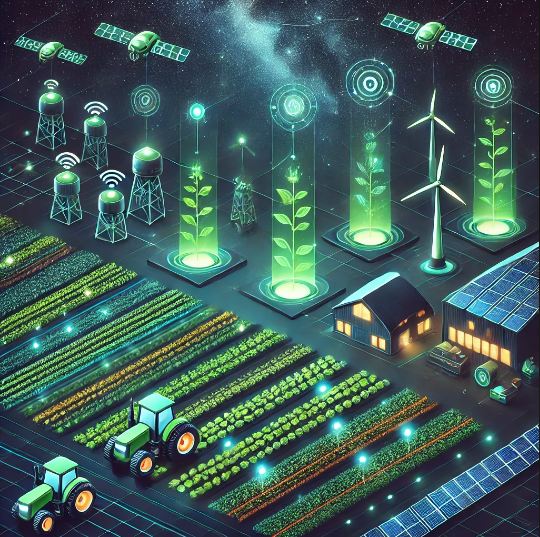Agriculture, the backbone of many economies worldwide, is evolving rapidly due to advancements in technology, changing consumer preferences, and the pressing need for sustainable practices. In recent years, new possibilities have emerged that hold the potential to revolutionize the agricultural sector, ensuring food security, improving farmers’ livelihoods, and addressing environmental challenges.
1. Precision Agriculture
Precision agriculture involves using technology to monitor and manage field variability in crops. By utilizing tools such as GPS, drones, sensors, and data analytics, farmers can optimize their resources and improve yields.
- Benefits:
- Efficient use of water, fertilizers, and pesticides.
- Reduction in production costs.
- Better crop health monitoring and disease prediction.
- Applications:
- Soil mapping to determine nutrient requirements.
- Variable rate technology (VRT) to adjust input levels across fields.
2. Smart Farming and IoT Integration
The integration of the Internet of Things (IoT) in agriculture enables real-time data collection and analysis. Smart farming solutions include connected devices such as automated irrigation systems, weather stations, and livestock monitoring collars.
- Advantages:
- Enhanced decision-making based on accurate data.
- Reduction in manual labor through automation.
- Improved animal welfare through constant monitoring.
- Example: IoT-enabled greenhouses that control temperature, humidity, and light to optimize plant growth.
3. Vertical and Urban Farming
Vertical farming involves growing crops in stacked layers, often in controlled environments like warehouses or skyscrapers. Urban farming brings agriculture into cities, using rooftops, vacant lots, and even walls.
- Key Features:
- Utilizes hydroponics, aeroponics, or aquaponics.
- Requires less water and land compared to traditional farming.
- Reduces the carbon footprint of transporting produce.
- Impact:
- Provides fresh produce to urban areas.
- Reduces dependency on rural farmland.
- Encourages local food production.
4. Genetic Innovations
Advancements in genetics have opened up new possibilities for developing crops that are more resilient, nutritious, and high-yielding. Techniques like CRISPR (Clustered Regularly Interspaced Short Palindromic Repeats) have revolutionized genetic engineering in agriculture.
- Applications:
- Developing drought-resistant and pest-resistant crops.
- Biofortification to increase nutritional content (e.g., Golden Rice enriched with Vitamin A).
- Reducing reliance on chemical inputs by enhancing natural pest resistance.
- Concerns and Solutions:
- Addressing ethical concerns around genetically modified organisms (GMOs) through transparent research and labeling.
5. Artificial Intelligence and Machine Learning
AI and machine learning are playing a transformative role in agriculture. From predicting weather patterns to analyzing soil health, these technologies are enabling smarter decision-making.
- Examples:
- AI-powered robots for harvesting and weeding.
- Crop monitoring systems that use satellite imagery and machine learning to predict yields.
- Chatbots providing real-time advisory services to farmers.
- Benefits:
- Increased productivity and reduced labor costs.
- Early detection of crop diseases.
- Optimized supply chain management.
6. Blockchain in Agriculture
Blockchain technology is being used to bring transparency and efficiency to agricultural supply chains. By creating a decentralized and tamper-proof ledger, blockchain ensures traceability and authenticity of agricultural products.
- Use Cases:
- Tracking the journey of produce from farm to fork.
- Ensuring fair trade practices and payment to farmers.
- Reducing food fraud and waste in supply chains.
7. Sustainable Practices and Climate-Resilient Agriculture
With climate change posing a significant threat to agriculture, adopting sustainable and climate-resilient practices is essential. Agroecology, organic farming, and regenerative agriculture are gaining momentum.
- Key Strategies:
- Crop rotation and intercropping to maintain soil fertility.
- Conservation agriculture to reduce soil erosion and carbon emissions.
- Agroforestry to integrate trees with crops and livestock for biodiversity.
- Technological Support:
- Weather forecasting tools to help farmers adapt to changing climatic conditions.
- Drought-tolerant and heat-resistant crop varieties.
8. Renewable Energy in Agriculture
Renewable energy sources, such as solar and wind power, are being integrated into farming operations to reduce dependency on fossil fuels and lower operational costs.
- Examples:
- Solar-powered irrigation systems.
- Biogas plants for waste management and energy production.
- Wind turbines on farms to generate electricity.
- Benefits:
- Reduces greenhouse gas emissions.
- Lowers energy costs for farmers.
- Promotes sustainable farming practices.
9. Aquaculture and Blue Economy
Aquaculture, or fish farming, is an emerging sector within agriculture. With the growing demand for seafood, sustainable aquaculture practices are becoming increasingly important.
- Innovations:
- Recirculating aquaculture systems (RAS) to recycle water.
- Integrated multi-trophic aquaculture (IMTA) to combine different species for ecosystem balance.
- Impact:
- Boosts income for coastal communities.
- Reduces pressure on wild fish stocks.
- Provides high-quality protein to meet global food demands.
10. Policy Support and Government Initiatives
Governments play a crucial role in fostering innovation in agriculture. Policies supporting research, technology adoption, and financial assistance to farmers are critical.
- Examples in India:
- The Pradhan Mantri Krishi Sinchayee Yojana (PMKSY) for efficient irrigation.
- E-NAM (National Agriculture Market) for creating a unified online marketplace.
- Kisan Credit Card scheme for affordable credit access.
Challenges and the Way Forward
Despite the exciting possibilities, the agricultural sector faces challenges such as limited access to technology for small-scale farmers, high initial investment costs, and resistance to change due to traditional practices.
- Solutions:
- Promoting digital literacy and training programs for farmers.
- Strengthening public-private partnerships to scale innovations.
- Providing subsidies and incentives for adopting sustainable technologies.
Conclusion
The agricultural sector is witnessing unprecedented transformation, driven by advancements in technology, sustainability initiatives, and innovative practices. By embracing these new possibilities, the sector can address pressing challenges such as food security, climate change, and rural development. The future of agriculture lies in harmonizing modern technology with traditional wisdom to create a resilient and inclusive food system.




